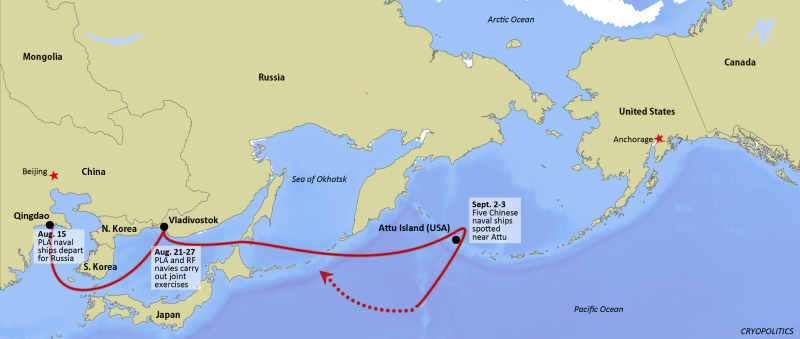Blog: Chinese naval ships near Aleutians

A few days ago, the U.S. Navy reported that it had detected five Chinese naval ships near the Aleutian Islands.
The vessels – supposedly three Chinese combat ships, a replenishment vessel and an amphibious landing ship – were spotted transiting U.S. territorial waters near Attu, which is the easternmost island belonging to the U.S. in the volcanic chain. At the time, President Obama was visiting Alaska. But despite the potential for harsh words, the U.S. government reacted calmly. “They were operating in international waters as U.S. ships operate in international waters. And so we didn’t take it as a particular threat,” remarked Pentagon Press Secretary Peter Cook at a press briefing. Nothing to see here, folks.
Cook did downplay the Chinese naval ships’ route: if other Pentagon reports are to be believed, the ships actually transited U.S. territorial waters coming within 12 nautical miles of Attu, and not just international waters. However, they exercised the right of innocent passage, which is protected by the United Nations Convention on the Law of the Sea. The U.S. navy, too, continually exercises this right around the world. Still, Conservative voices denounced the government’s nonchalant reaction. Joel Pollak, editor-in-chief of conservative news site Breitbart, penned a story entitled “Obama makes excuses for Chinese warships in U.S. waters.” But the U.S. government was probably right to downplay the Chinese passage. While it was a first for the People’s Liberation Army Navy (PLAN) to come so close to Alaskan/U.S. waters, the U.S. Navy has been doing the same thing in waters China considers its own for some time. Consider what David Shear, assistant secretary of defense for Asian and Pacific security affairs, said about the South China Sea in May 2015: “We claim the right of innocent passage in such areas, and we exercise that right regularly, both in the South China Sea and globally…We’re going to continue exercising that right, both on the surface of the waters and in the air.” Tit for tat.
The PLAN ships’ voyage in geographical and historical perspective
Thinking about the presence of U.S. ships geographically and historically demonstrates two things. First, Attu Island is closer to Russia* than mainland Alaska. Attu is even closer to Beijing than Washington, D.C. As Dermot Cole wrote in the Anchorage Daily News, most media coverage ignored the size and scale of Alaska, making the Chinese vessels’ excursion seem more threatening than it actually was. Cole wrote, “By not making it clear that the Aleutians extend more than 1,000 miles from Unimak Island to Attu Island, it was like saying that something happened in the Pacific Ocean between Juneau and Seattle.” Putting the story into sharper geographical focus reveals that the Chinese naval ships were scoping out waters that constitute their relative backyard – waters that lead to the Bering Strait, the country’s main access point to the Arctic Ocean. As the PLAN grows stronger and seeks to exert more influence around the world to, in theory, ensure freedom of the seas for both itself and the country’s commercial fleets, seeing their ships near the Aleutians will likely become a more routine occurrence that is not necessarily cause for anxiety.
Second, historically, Chinese presence in the North Pacific Ocean revives historical connections between northern Eurasia and North America. A story that fell under the radar this week compared to the big bad Chinese naval ships concerned a 17th-century Chinese coin. The Qing dynasty-era coin was found in 2011 during an archaeological dig on land belonging to the Kwanlin Dun First Nation in Yukon, about 150 miles northwest of Whitehorse, where it is now on display at the Kwanlin Dun cultural center. In an interview with CBC, Sean Smith, a Kwanlin Dun councillor, remarked that the coin was evidence of the First Nation’s ties with the Chinese market via Russian and coastal Tlingit traders. At the time, Russians were plying the North Pacific in search of furs in the west, which they could sell in the east. Smith elaborated,
“The significance is also … the history of my people being in this area, to hunt to live, to fish, to trade with other people and to develop relationships with other people that were coming in and out of this land.”
Attu: Nobody’s home
Juxtaposing the story of the Chinese coin with the five Chinese naval ships, it’s clear that the North Pacific Ocean has served as a place of exchange between east and west for centuries both in peace and in war. I’ve written previously about the furs collected by indigenous peoples in northern Canada and sold in China and the invasion of Attu and Kiska by Japanese soldiers during World War II. In the latter post, I even wrote that “nobody lives on Attu anymore.” Perhaps Joel Pollak of Breitbart might want to reopen the U.S. Coast Guard Loran Station Attu, decommissioned in August 2010. With the U.S. presence in the Aleutians having shrunk, the five Chinese naval ships seen last week near Attu underscore that Asian presence around the Aleutian Islands and the North Pacific – closer to their countries than to the Lower 48 – may increasingly become the norm more than the exception.
The week before being tracked by the U.S. military around Attu, the five Chinese vessels, with two other PLAN ships, had participated in joint amphibious assault exercises with the Russian Navy in the Peter the Great Gulf, around Vladivostok. As China and Russia assert more naval power, we can expect to see more demonstrations of might like these exercises on the eastern side of the Pacific. Let’s not forget the other side of the coin, which is that as the Chinese economy expands (its current downturn notwithstanding), North American communities on the western side of the Pacific can expect to see an influx of Chinese goods and money – just as they did during the 17th century.
*It’s worth noting that the part of Russia that Attu is near, Kamchatka, might as well be the edge of the world to most Russians living in St. Petersburg and Moscow.
Related stories from around the North:
Asia: Asia ahead on preparing for polar climate change, says U.S. Arctic rep, Eye on the Arctic
Canada: Canada to collect more data for continental shelf claim, Eye on the Arctic
China: Chinese company mulls more Arctic shipping, Barents Observer
Finland: Finland wants in on US icebreaker investment, Yle News
Norway: China eyes Arctic Norway infrastructure projects, Barents Observer
Russia: Russia, China cooperate on railroad to Arctic, Barents Observer
Russia: New law would allow only Russian-flagged ships in Russian Arctic, Barents Observer
Sweden: Swedish icebreakers gear up for Arctic role, Radio Sweden
United States: U.S. officials consider leasing icebreakers as budget reality sinks in, Alaska Dispatch News



